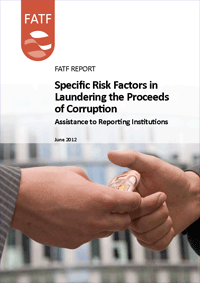Are there specific types of business relationships, customers, or products which should lead a reporting institution to pay particular attention to the risk of corruption-related money laundering?
The 2011 FATF publication Laundering the Proceeds of Corruption discussed the interrelationship between corruption and money laundering. It identified the most common methods used to launder the proceeds of corruption, and highlighted the vulnerabilities leading to an increased risk of corruption-related money laundering. The publication also identified areas in which future work could be done, including gaining an understanding of the correlation between certain risk factors and corruption.
The report Specific Risk Factors in the Laundering of Proceeds of Corruption was written to assist reporting institutions to better analyse and better understand specific risk factors that may assist them in identifying situations posing a heightened risk of corruption-related money laundering risk.
The new FATF Recommendations require a reporting entity to have “appropriate” risk management systems in place to determine whether the customer or the beneficial owner is a foreign politically exposed person (PEP), and take “reasonable measures” to determine whether a customer or beneficial owner is a domestic PEP or an individual entrusted with a prominent function by an international organisation. To gauge whether a system is “appropriate,” or whether “reasonable measures” have been taken, requires an assessment of risk.
Understanding risk is important after identifying domestic PEPs or relevant individuals from international organisations, in order to assess what level of enhanced due diligence is necessary.
Experience teaches us that combating corruption-related money laundering must be more than simply ensuring that PEPs receive an appropriate level of scrutiny. It is a rare case (although not unheard of) for a PEP to enter a financial institution and deposit (or transfer) significant amounts of suspicious money. Such action would likely create unacceptable risks to the PEP of detection by reporting institutions.
As Laundering the Proceeds of Corruption noted, corrupt PEPs will take great pains to disguise the identity and the source of the funds in order to place corrupt money in the financial system without suspicion. Therefore, an effective AML scheme requires an assessment of corruption-related risk and protecting against the laundering of corruption proceeds across the spectrum of customers and business relationships, regardless of whether a FATF-defined PEP is involved.


 Twitter
Twitter
 Facebook
Facebook
 Instagram
Instagram
 Linkedin
Linkedin
